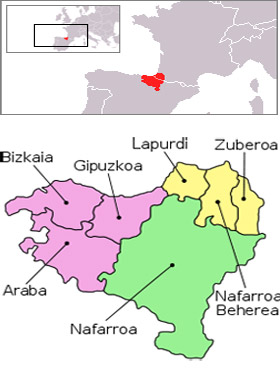The Basque Country, Pays Basque or Euskal-herri is a region which straddles the mountainous region of south western France and north western Spain, extending around the coast of the Bay of Biscay. It consists of the three French Basque provinces (Iparralde (north zone)) of Soule (Zuberoa in Basque), Lower Navarre (Behe Nafarroa in Basque, Basse-Navarre in French) and Labourd (Lapurdi in Basque) and four Spanish Basque provinces (Hegoalde (south zone)) of Álava (Araba in Basque), Guipúzcoa (Gipuzkoa in Basque), Navarre (Nafarroa in Basque, Navarra in Spanish) and Biscay (Bizkaia in Basque, Vizcaya in Spanish).
The origins of the Basque people pre-date the Indo-European settlements of Europe. The Basque language, spoken by 20% of the current population, is very different from Gaellic and European languages spoken in the rest of the world today. The Basques also have a very distinct and lively culture, with sports such as Pelota and their own cuisine.
In Spain, the Basque cuisine is very highly regarded. It is not exotic or elaborate, but relies on perfect ingredients. The seafood from the cold waters of the Bay of Biscay is renowned. Strangely, the Basques have a history of importing salt cod from Newfoundland and Norway and many dishes are based on bacalao. Unlike other parts of Spain, sauces are made to accompany fish and meat dishes, and these might be made with red peppers, tomatoes, garlic, cuttlefish ink or green herbs, especially parsley. These take the form of pil-pil (white), salsa verde (green) and vizcaina (red) and en su tinta (black). The lush mountain pastures support grazing animals and the Basque country is known for its lamb and veal, as well as feathered and furred game Another well- known product of the region is Bayonne ham. The Spanish province of Álava produces maize, sugar beet, wine and fruits.
The cuisine of the region is taken so seriously by its inhabitants (always a good sign) that there are numerous male-dominated (not such a good sign!) societies, members of which use the facilities of the society to cook meals for one another, competing for excellence. Some are so serious that only the death of a member will allow the opportunity for a new one to be elected.
Basse-Navarre was previously the north of the Kingdom of Navarre, capital Pamplona (now in Spain), that was conquered by the Spanish Kings in 16th Century and seperated into two provinces, Basse (Low) to the North and Haute (High) to the South. Pamplona remained capital of the Haute-Navarre, while Saint-Palais became capital of the Basse-Navarre, under the control of the Bourbons. The borders of Navarre had changed over time and various attempts had been made to unify all the Basque people under the throne of Navarre. However the division of the Kingdom into two provinces eventually led to the division of Navarre between France and Spain that exists today.
Geographically, inland Pays Basque is very similar to Béarn, with foothills, valleys and mountains. The Pays Basque, however is particularly famous for the Basque Coast (Côte Basque) with the popular costal resorts of Biarritz and Saint Jean-de-Luz.
